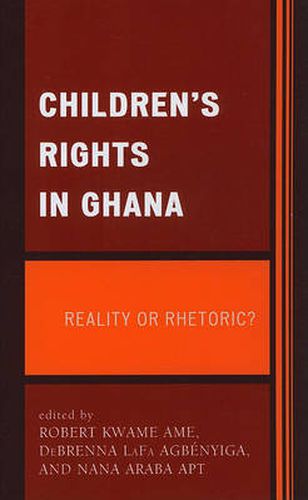Readings Newsletter
Become a Readings Member to make your shopping experience even easier.
Sign in or sign up for free!
You’re not far away from qualifying for FREE standard shipping within Australia
You’ve qualified for FREE standard shipping within Australia
The cart is loading…






This is the first book that examines Ghana’s compliance with the United Nations Convention on the Rights of the Child (CRC). Ghana being the first country to ratify the Convention, it thus fills an important gap in the literature on Ghana. The book throws a searchlight on a wide range of rights issues including children’s identity, violence against children and women, child exploitation and children in conflict with the law plus a host of other CRC related issues and further identifies and explains the main obstacles in the way of realizing children’s rights in Ghana. A major strength of this book is that the contributors, Ghanaians and non-Ghanaians alike have vast experience in empirical research in Ghana and most importantly, come from diverse academic disciplines. Researchers, instructors, and students of Social Work, Sociology, Criminology Human Rights, Education and Law, are examples of a few academic disciplines that would find this book a welcome relief in their search for relevant and current data on children’s issues in Ghana. It should also be of great interest to policy makers, human rights activists, Children’s NGOs and international development partners interested in children’s issues.
$9.00 standard shipping within Australia
FREE standard shipping within Australia for orders over $100.00
Express & International shipping calculated at checkout
This is the first book that examines Ghana’s compliance with the United Nations Convention on the Rights of the Child (CRC). Ghana being the first country to ratify the Convention, it thus fills an important gap in the literature on Ghana. The book throws a searchlight on a wide range of rights issues including children’s identity, violence against children and women, child exploitation and children in conflict with the law plus a host of other CRC related issues and further identifies and explains the main obstacles in the way of realizing children’s rights in Ghana. A major strength of this book is that the contributors, Ghanaians and non-Ghanaians alike have vast experience in empirical research in Ghana and most importantly, come from diverse academic disciplines. Researchers, instructors, and students of Social Work, Sociology, Criminology Human Rights, Education and Law, are examples of a few academic disciplines that would find this book a welcome relief in their search for relevant and current data on children’s issues in Ghana. It should also be of great interest to policy makers, human rights activists, Children’s NGOs and international development partners interested in children’s issues.